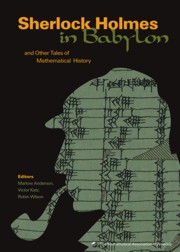Book contents
- Frontmatter
- Introduction
- Contents
- Ancient Mathematics
- Foreword
- Sherlock Holmes in Babylon
- Words and Pictures: New Light on Plimpton 322
- Mathematics, 600 B.C.–600 A.D.
- Diophantus of Alexandria
- Hypatia of Alexandria
- Hypatia and Her Mathematics
- The Evolution of Mathematics in Ancient China
- Liu Hui and the First Golden Age of Chinese Mathematics
- Number Systems of the North American Indians
- The Number System of the Mayas
- Before The Conquest
- Afterword
- Medieval and Renaissance Mathematics
- The Seventeenth Century
- The Eighteenth Century
- Index
- About the Editors
Before The Conquest
from Ancient Mathematics
- Frontmatter
- Introduction
- Contents
- Ancient Mathematics
- Foreword
- Sherlock Holmes in Babylon
- Words and Pictures: New Light on Plimpton 322
- Mathematics, 600 B.C.–600 A.D.
- Diophantus of Alexandria
- Hypatia of Alexandria
- Hypatia and Her Mathematics
- The Evolution of Mathematics in Ancient China
- Liu Hui and the First Golden Age of Chinese Mathematics
- Number Systems of the North American Indians
- The Number System of the Mayas
- Before The Conquest
- Afterword
- Medieval and Renaissance Mathematics
- The Seventeenth Century
- The Eighteenth Century
- Index
- About the Editors
Summary
Introduction
In the late 15th century, through their explorers, Europeans “discovered” the New World. Although the discovery would cause drastic change, the New World was, of course, not new to its inhabitants. When the Europeans arrived, there were at least 9 million people in about 800 different cultures living in the Western Hemisphere. Because of the vast disruptions that eventually took place, what we know about them and their mathematical ideas is limited. Most of the cultures had no writing as we commonly use the term and so there are no writings by them in their own words. For the cultures that did not survive, we have primarily what can be learned from archaeology and from the writings of the Europeans of the time, who had little understanding and little respect for these cultures so different from their own. For those that did survive, we also have their oral traditions.
We focus here on the mathematical ideas of two sizable groups, the Incas and the Maya. The regions the groups inhabited, their cultures, and their histories are quite distinct, as are their mathematical ideas. Fortunately, for both groups, there is sufficient information for us to gain some understanding of their rich and complex ideas. Here we present an abbreviated introduction to the content and context of the sophisticated data handling system of the Incas and the intricate calendric system of the Maya.
- Type
- Chapter
- Information
- Sherlock Holmes in BabylonAnd Other Tales of Mathematical History, pp. 98 - 104Publisher: Mathematical Association of AmericaPrint publication year: 2003

